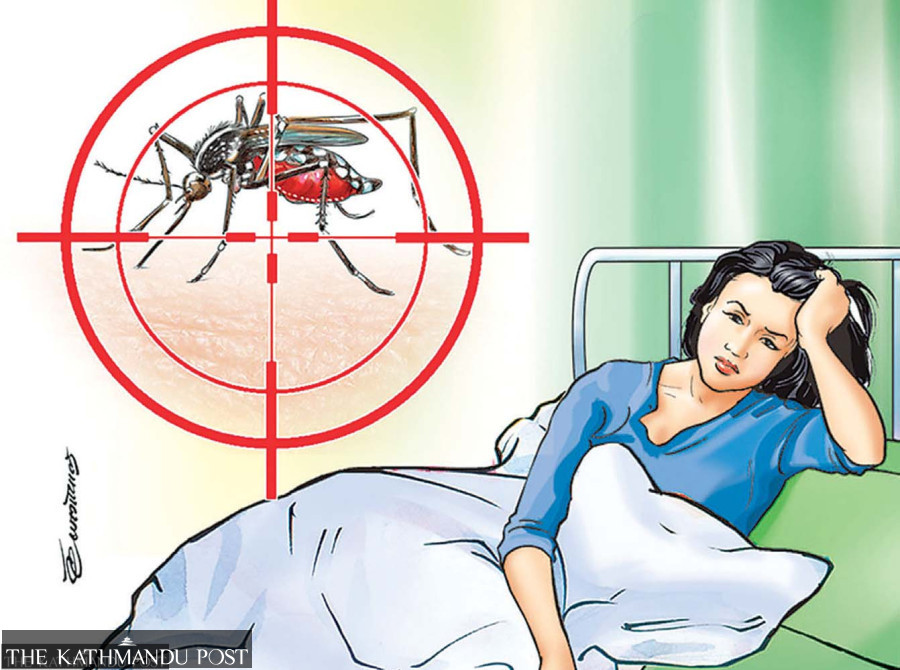Health
15 dead, 28,000 infected with dengue this year
Actual infections may be higher due to reporting glitches with most cases being asymptomatic, say officials.
Arjun Poudel
At least 15 persons have died, including children and a new mother, from dengue infection that has spread to all of the country’s districts except Humla so far this year, officials said.
The number of deaths could go up as authorities are verifying several reported deaths from the infection of the deadly virus, said Gokarna Dahal, chief of the Vector Control Section at the Epidemiological and Disease Control Division.
Dengue is a mosquito-borne disease transmitted by female Aedes aegypti and Aedes albopictus mosquitoes. The same vector also transmits chikungunya, yellow fever, and Zika, according to the World Health Organisation.
Dengue-transmitting mosquitoes breed in clean water and bite people in daylight. Uncovered water tanks and other discarded objects such as plastic cups and bottles could be breeding grounds for the dengue-carrying mosquitoes.
Symptoms of dengue include mild to high fever, severe muscle pain, rashes, severe headache and pain in the eyes, doctors say. They advise that patients with these symptoms should seek immediate treatment. While there is no specific cure for the disease, an early detection and access to proper medical care can prevent death.
More than 28,000 cases of infection have so far been reported this year. Officials said that the real number of infected persons could be several times higher as the government’s case reporting system is not effective and more than 80 percent cases are asymptomatic. Many people infected with dengue show mild symptoms and do not need any treatment or can be treated with paracetamol at home.
Last year, 88 people died and more than 54,000 were infected by the virus, which had spread to all 77 districts of the country. At the time, hospitals in Kathmandu Valley were overwhelmed with dengue patients and pharmacies had run out of paracetamol, the most widely used medicine to treat fever.
In 2019, the disease killed at least six people and more than 16,000 were hospitalised across the country. The virus had spread to 68 districts at the time.
Officials at the Ministry of Health and Population said that they have been planning long-term measures to deal with the dengue virus which has emerged as a major public health scare in the country.
“This is the second consecutive year in which we have seen a major outbreak of the dengue virus,” said Dahal of the disease control division. “We plan to set up entomological labs in all seven provinces of the country for vector surveillance and testing.”
As the country does not have a sufficient number of entomologists to serve in all seven provinces, health ministry officials plan to impart entomological training to health workers. Dahal said they will start training health workers in the next couple of days.
Epidemiologists as well as virologists said dengue virus has of late emerged as a major public health problem in Nepal as the disease has become endemic. They also said that despite thousands of persons getting infected and scores dying from the disease, the concerned authorities have not taken it seriously.
This year, five districts, including Kathmandu, have reported more than 500 cases of dengue infection. Sunsari district has reported 15,881 cases of infection, Dhading 2,992, Morang 2,261, Jhapa, 1,394 and Kathmandu 517 cases.
Experts say the lackadaisical approach of the concerned authorities is responsible for the spread of the dengue virus. They say measures such as search-and-destroy and awareness drives should be initiated to contain the spread of virus-spreading vectors.
A report by the United Nations titled “Climate Change 2022: Impacts, Adaptation and Vulnerability” states that at least six major vector-borne diseases have recently emerged in Nepal and are now considered endemic, with climate change implicated as the primary driver.
The report also showed increasing evidence that climate change has extended the elevational distribution of Anopheles, Culex and Aedes mosquitoes, which carry viruses to above 2,000 metres in Nepal.




 10.12°C Kathmandu
10.12°C Kathmandu














